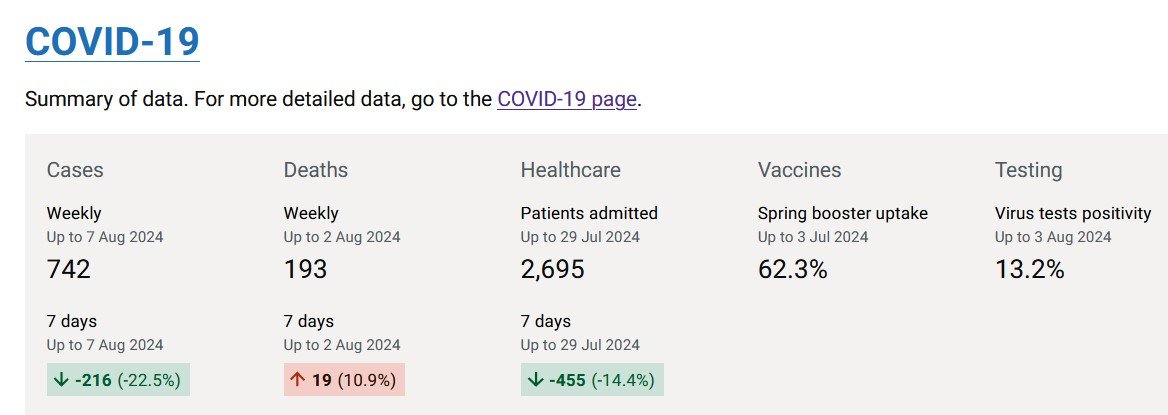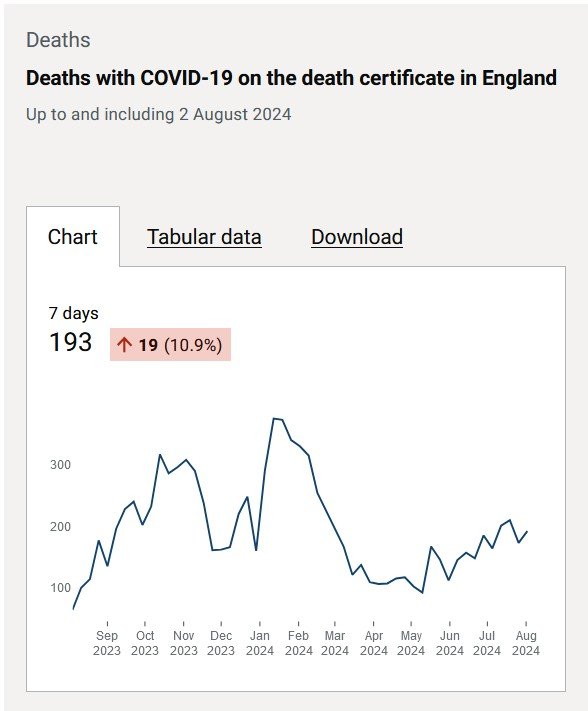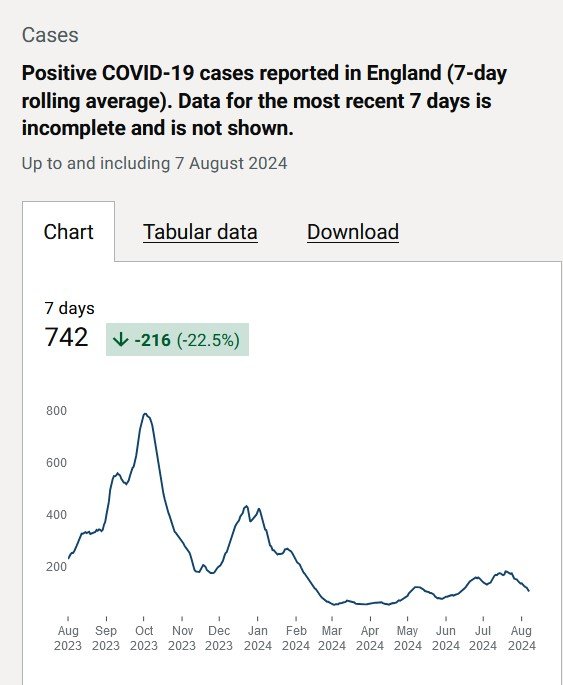-
Posts
37,019 -
Joined
-
Last visited
-
Days Won
6
Content Type
Events
Forums
Downloads
Quizzes
Gallery
Blogs
Everything posted by TallGuyJohninBKK
-
10 Aug 2024 Meta Platforms defeated an appeal by Children's Health Defense, an anti-vaccine group founded by Robert F Kennedy Jr, challenging its censorship of Facebook posts that spread misinformation about vaccines' efficacy and safety. In a decision on Friday, the 9th US Circuit Court of Appeals in Pasadena, California, said the nonprofit did not show that Meta worked with or was coerced by federal officials to suppress views challenging "government orthodoxy" on vaccines. ... Circuit Judge Eric Miller, appointed to the court by Republican former President Donald Trump, wrote for the appeals court that Meta was a "purely private" company with a First Amendment right not to use its platform to promote views it found distasteful. ... Friday's decision upheld a June 2021 ruling by US District Judge Susan Illston in San Francisco. (more) Source: Reuters Channel News Asia https://www.channelnewsasia.com/business/meta-beats-censorship-lawsuit-rfk-jrs-anti-vaccine-group-4538601
-
- 1
-

-
Hong Kong to stop offering Sinovac Covid vaccine when current stocks expire in October Authorities say they expect new jab targeting prevalent JN.1 variant will be available by the end of the year 9 Aug 2024 The Sinovac Covid-19 vaccine will no longer be offered in Hong Kong from early October, with authorities saying they expect a new jab targeting the prevalent coronavirus variant to be available by the end of the year. ... The new jabs are expected to be supplied for use by the year’s end, with new vaccination arrangements to be announced later. The centre said Covid-19 levels had been increasing locally since June and were expected to rise further. ... Arrangements for boosters will remain the same, and eligible high-risk groups will continue to enjoy free vaccinations at least six months after their last shot or Covid-19 infection, regardless of the number of doses received previously. Those groups include adults aged 50 or above, people aged 18 to 49 with underlying comorbidities, those aged six months and above with immunocompromising conditions, pregnant women and healthcare workers. (more) South China Morning Post https://www.scmp.com/news/hong-kong/health-environment/article/3273775/hong-kong-stop-offering-sinovac-covid-vaccine-when-current-stocks-expire-october
-
- 1
-

-

Periodic COVID updates for South Korea
TallGuyJohninBKK replied to TallGuyJohninBKK's topic in COVID-19 Coronavirus
COVID-19 surge fuels fears of hidden spread, with less data, fewer tests Sticking to preventive measures, testing for COVID-19 if signs appear could tame spread, experts say Aug. 15, 2024 The recent surge in COVID-19 infections is stoking concerns of hidden, unchecked community spread, intensified by reduced data collection from Korean government agencies and a decline in testing rates. ... The number of patients hospitalized with COVID-19 at 220 hospital-level medical institutions stood at 1,357 in the second week of August [emphasis added], according to the Korea Disease Control and Prevention Agency on Wednesday. This is a sharp rise from 148 in the second week of July to 226 in the third week and 475 the following week. The corresponding figure for the first week of this month was 861. [emphasis added] Most hospitalized patients were over 65 years old. (more) https://www.koreaherald.com/view.php?ud=20240815050087 -
In the latest weekly update from the Taiwan CDC, severe COVID cases and new COVID deaths both declined from the prior week. The Taiwan CDC's headline from Aug. 13: The domestic COVID-19 epidemic situation is declining, but it is still in the epidemic period and the number of severe cases and deaths is still high. It is recommended that the public get the COVID-19 XBB vaccine as soon as possible to reduce the risk of severe illness The following is this poster's trends recap of prior Taiwan CDC reporting on severe cases and COVID deaths: Week Ending -- Severe COVID cases -- COVID Deaths June 17 -- 624 -- N/A June 24 -- 817 -- 40 July 1 -- 932 -- 64 July 8 -- 987 -- 99 July 15 -- 896 (revised) -- 104 July 22 -- 773 -- 124 July 29 -- 584 -- 90 Aug. 5 -- 445 -- 104 Aug. 13 -- 347 -- 57 The CDC also reported that most of the severe COVID cases and COVID deaths involved people age 65 and older. Regarding COVID vaccinations, the CDC reported: "As the epidemic at home and abroad continues, and more than 91% of confirmed domestic complications and deaths have not been vaccinated against COVID-19, we call on those who have not yet been vaccinated against COVID-19 to get vaccinated as soon as possible." "The CDC pointed out that the global COVID-19 positivity rate has been on an upward trend recently. Among them, the positivity rate in Africa and Southeast Asia has increased, while the positivity rate in the Eastern Mediterranean region has fluctuated. In some countries, such as China, the positivity rate has continued to rise since early July, and the United States has continued to rise since May. The positivity rate and emergency room visit rate have continued to rise since mid-month. The number of cases in Japan has declined but is still at a high point. The number of cases in Italy, Russia, Greece, the United Kingdom, New Zealand and other countries is also at a high point." Source: Taiwan CDC
-

Periodic COVID updates for England
TallGuyJohninBKK replied to TallGuyJohninBKK's topic in COVID-19 Coronavirus
Here's the charts from the latest UKHSA weekly COVID update for England as of Aug. 15: My text summary - Although new COVID deaths at 193 rebounded back toward the 200 per week level by the start of August, other publicly reported COVID indicators for England showed improvement / declines in the latest weekly update. Those included declines in new weekly COVID cases (not an especially reliable indicator these days), and a substantial decline in the positivity rate for COVID tests (7-day rolling average), which dropped from 14.8% previously to 13.2% in the latest weekly report. There was no updated data for COVID new hospital admissions since the prior weekly report. https://ukhsa-dashboard.data.gov.uk/ https://ukhsa-dashboard.data.gov.uk/topics/covid-19#deaths Weekly COVID deaths from the recent weekly low in May: Weekly data for deaths with COVID-19 on the death certificate in England Up to and including 2 August 2024 (some recent prior week figures have been revised vs prior weekly reports): Date -- Amount 2 Aug 2024 -- 193 26 Jul 2024 -- 174 19 Jul 2024 -- 211 12 Jul 2024 -- 202 5 Jul 2024 -- 165 28 Jun 2024 -- 186 21 Jun 2024 -- 149 14 Jun 2024 -- 158 7 Jun 2024 -- 146 31 May 2024 -- 113 24 May 2024 -- 147 17 May 2024 -- 168 10 May 2024 -- 93 https://ukhsa-dashboard.data.gov.uk/ https://ukhsa-dashboard.data.gov.uk/ https://ukhsa-dashboard.data.gov.uk/topics/covid-19#testing -
I prefer my salmon steaks baked in the oven, which gives them a firmer and crispier exterior without having to pan fry them... And usually topping those with EV olive oil or some avocado salsa I import from the U.S. But if I was going to cook them for eating cold, such as flaked in a salad, ya, poaching would be my way to go...
-
Yes we need to worry so much about Soros buying a stake in radio stations (which for the most part aren't primary national news providers in the U.S.)... But meanwhile, let's ignore arch right winger Rupert Murdoch and his family's far right-wing influence over many more primary U.S. news sources, including the Wall Street Journal, New York Post, the Fox News network, and others. Who Owns Your News? The Top 100 Digital News Outlets and Their Ownership Who Owns the Media in the U.S.? About 15 billionaires and six corporations own most of the U.S. media outlets. The biggest media conglomerates in America are AT&T, Comcast, The Walt Disney Company, National Amusements (which includes Viacom Inc. and CBS), News Corp and Fox Corporation (which are both owned in part by the Murdochs), [emphasis added] Sony, and Hearst Communications. All of them save for Sony make an appearance in our online news sources chart. ... Who Owns the Fox News Network? Fox News is owned by the Fox Corporation, which is owned in part by the Murdoch Family (39% share). It’s also important to point out that the same person with Fox News ownership, Rupert Murdoch, owns News Corp with the same 39% share, and News Corp owns the New York Post, HarperCollins, and the Wall Street Journal." https://www.titlemax.com/discovery-center/who-owns-your-news-the-top-100-digital-news-outlets-and-their-ownership/ Strange, I don't see George Soros' name anywhere on the linked list of owners of the major news sources in the U.S. But the Murdoch family absolutely are. Forbes magazine in 2016 said Murdoch "may well be the world's most powerful media tycoon." https://www.forbes.com/sites/katevinton/2016/06/01/these-15-billionaires-own-americas-news-media-companies/#29ae3f3e660a And last time I checked, he's the only U.S. news media mogul whose corporation ended up having to pay a $787 million settlement to voting machine maker Dominion Voting Systems because of Fox hosts' pervasive attempts to undermine the credibility of the U.S. presidential election system during the 2020 cycle with known false claims in an attempt to favor their favored candidate (Trump) and echoing his likewise false claims. "Dominion Voting Systems v. Fox News Network (colloquially Dominion v. Fox) was a U.S. defamation lawsuit filed in March 2021 by Dominion Voting Systems against Fox News Channel and its corporate parent Fox Corporation. Dominion's complaint sought US$1.6 billion in damages, alleging several Fox programs had broadcast false statements that Dominion's voting machines had been rigged to steal the 2020 United States presidential election from then-president Donald Trump. ... Dominion focused on allegations made between November 2020 and January 2021 by hosts Maria Bartiromo, Tucker Carlson, Lou Dobbs, Sean Hannity, and Jeanine Pirro. Guests who often appeared with these hosts included Trump attorneys Rudy Giuliani and Sidney Powell, both of whom have also been sued individually by Dominion in federal court.[a] During pre-trial discovery, Fox News' internal communications were released, indicating that prominent hosts and top executives were aware the network was reporting false statements but continued doing so to retain viewers for financial reasons. On April 18, 2023, as opening statements were about to begin, the judge announced that the parties had reached a settlement. Fox News agreed to pay Dominion $787.5 million and acknowledged the court's earlier ruling that Fox had broadcast false statements about Dominion. The settlement did not require Fox News to apologize. It is the largest known media settlement for defamation in U.S. history. " https://en.wikipedia.org/wiki/Dominion_Voting_Systems_v._Fox_News_Network
-
As an aside, interesting getting a feel for people's popular menu choices here... Chicken and chips (like french fries in U.S. parlance) seems to be a common theme! 🙂
-
An interesting explainer here on the differences between halogen ovens and air fryers... and the author definitely comes down on one side in terms of which cooks food more quickly and, to the author's taste, produces better food results. https://www.idealhome.co.uk/kitchen/halogen-oven-vs-air-fryer PS - this was one of the first search results that popped up in Google when I did a search on comparing the two types.
-
And in my experience, 90+% of condos in Bangkok where Thais live seem to come with no oven whatsoever when built, except for small microwaves.....
-
Entirely new and no experience with air fryers... Never had or used one... All I know is, my wife wants to cook salmon steaks and fresh veggies like broccoli.... I have no idea what kind of temp you'd use in an air fryer for something like fresh broccoli florets. But healthwise, afaik, there's no reason you couldn't or shouldn't cook those two items at the same time in the same device...
-
Is this the one you're referring to... a unit with a glass body? I can't tell if it's a halogen model or not... https://www.makro.pro/en/p/2xrtgq6-7352839438531?
-
Thanks for the advice! What exactly do you mean above re cooking things simultaneously? Do you mean the ability to handle larger, multi item portions that wouldn't fit in the unit? Or, that you can't cook things like fish fillets and vegetables in the same cooking cycle together, even if the air fryer size can handle them?
-
So what would you recommend as a minimum optimal size to get in terms of Liters capacity?
-
Got all those already, but not really fitting what we and she needs. When she fries fish on the stove, it stinks up the whole house (we have an open kitchen and living room area combined). When she steams veggies on a big steamer pot on the stove, it heats up and humidifies the whole kitchen and beyond. I think ideally I'd be looking for something cleaner in all the various respects when it comes to cooking -- not making our living area hot, humid or stinky.
-
I don't know what's going on with Xiaomi branded items being sold by 3rd parties on Lazada and elsewhere, but I ran into the same "dubious product" issue with them lately... I saw models of a home indoor PM2.5 monitor branded Xiaomi being advertised/sold on Lazada, AliExpress and elsewhere at very low prices... and I was interested. So one day when I was in the local mall, I stopped in when I saw the official Xiaomi company store there, and inquired about their PM2.5 monitor units... And was told by the Xiaomi store staff that they don't make or sell PM2.5 monitors, at least not in the Thailand market.... And a subsequent search I did of Xiaomi's global and various country-based websites surfaced no such product of theirs. So it seems something squirrely is going on.
-
Thanks for your post, since I was hoping someone would actually come along and address the gist of the OP's question... being the differences between and how to choose between buying/using an air fryer vs. a halogen oven. Can you offer an elaboration on how the cooked food emerges from the air fryer vs the halogen oven? And whether one or the other is better for cooking certain types of foods? My wife wants to get one (something) for our home to assist with her latest home cooking efforts. But I think it's going to be up to me to decide just what that something ought to be... We already have a good microwave oven and slow cooker units at home. So I think she's looking at wanting to cook things like salmon steaks and fresh veggies without frying in oil or heating up the whole house via stovetop steaming. PS - I had no idea the manufacture of halogen bulbs is being phased out, so that for me also becomes a consideration as well!
-
Since we're now throwing in random quotations, I'll add the following counterpoint opinion: Kent Sepkowitz is a physician and infectious disease expert at Memorial Sloan Kettering Cancer Center in New York who takes issue with economists and others who faulted the early lockdowns in the U.S., and maintains they were absolutely warranted in the early going. Opinion: Were Covid-19 lockdowns a mistake? November 10, 2023 ... "In other words, I consider the “short-term benefits” [early in the pandemic] to be absolutely critical in allowing the medical world to steady itself and gain a much firmer grasp of the task at hand. One only had to work in health care in New York City to see the difference between early 2020, when the explosion of cases overwhelmed the city, versus later in 2020 when an effective therapy had been identified, supplies and diagnostic testing had been greatly improved (though still completely inadequate) and the makeshift ICUs and emergency rooms had been set in place. ... The “short-term benefits” at the start of the pandemic are simple to characterize: Every infection that was delayed due to the lockdowns was a day to the good, a day closer to the release of the mRNA vaccines in December 2020, a less-hectic day for the health care workers, a day for clinical trials to mature. Therefore, the authors’ statement that lockdowns “were a mistake that should not be repeated” because they had no “purpose other than keeping hospitals from being overrun in the short-term” is to me a fundamental misunderstanding of the day-to-day work that was being done. ... I do think that a practical conclusion that we may send to those caught up in a future pandemic of respiratory virus is this: Lock down hard and quickly until you and the world can get your bearings. Maintaining a functional health care system is crucial." https://www.cnn.com/2023/11/10/opinions/covid-19-pandemic-lockdowns-sepkowitz/index.html
-
My elderly father died of a non-COVID related cause during a brief hospitalization in the U.S. in the early months of the pandemic in 2020, months before the first COVID vaccines became available. The private hospital where he was admitted at the time had serious restrictions on out-of-hospital visitors, even for family members, though phone calls and video calls were fine. However, when it was clear his death was imminent, the hospital allowed a few family members in wearing face masks for a brief visit (he was unconscious at the time). The obvious purpose of such policies was to try to prevent and limit the further spread of COVID as a deadly infectious disease at the time among hospital staff and patients. I had no problem with the COVID policy the hospital enforced back then, and was glad they were doing their best to protect the health of both their patients and staff under extremely difficult circumstances, as Patong2021's post above illustrates. At least in the U.S., where there isn't any nationalized health care system, I don't think there was any single nationwide policy on such things among thousands of different hospitals, both public and private.
-
Other pertinent findings from the same OECD source, which looked at COVID related outcomes thru December 2021: --"Vaccination strategy matters. A higher COVID-19 vaccination rate was associated with lower excess mortality." --"The pandemic has claimed, and continues to claim, millions of lives. Across OECD countries, more than 3.1 million people have died representing nearly half of the 6.6 million reported global fatalities (as of December 2022). Reported COVID-19 deaths underestimate the true death toll, however, owing to a lack of testing and accurate reporting. [emphasis added] The document also addresses the differences between actual recorded COVID deaths and estimates of excess mortality during the pandemic compared to prior years: "While the number of reported COVID-19 deaths offers the most direct measure of the number of lives lost to the pandemic, differences in testing capacities, recording, registration and coding practices across countries hamper the international comparability of these figures. Additional indicators to assess the full impact of COVID-19 on population health are therefore useful. The indicator “excess deaths” offers a broader measure, reflecting both the direct and indirect impact of the SARS-CoV-2 virus on mortality, with standardised reporting across OECD countries. It is not affected by capacity limitations to detect COVID-19 fatalities in countries or other differences in the registration of COVID-19 deaths. However, it is not a direct measure of the impact of COVID-19, since it captures all excess deaths in a particular period, irrespective of their cause. This can include other health events, such as exceptional influenza seasons or extreme weather, which have differing mortality impacts across countries." https://www.oecd-ilibrary.org/sites/1e53cf80-en/1/3/3/index.html?itemId=/content/publication/1e53cf80-en&_csp_=da51eb48eaaeedf7fcdf3f0f2a953149&itemIGO=oecd&itemContentType=book#section-d1e10677-66f043643c --
-
If you look at Sweden's per capita COVID death rate for 2020-2021, not looking so good compared to its comparable Nordic neighbors. From the same OECD source: COVID deaths for 2020-21 per million population: Norway: 242 Finland: 310 Denmark: 558 Sweden: 1,463 On the same broader OECD chart for "Country dashboard of COVID-19 outcomes, 2020 and 2021": Denmark did better than the OECD average on 3 out of 6 indicators Finland did better than the OECD average on 3 out of 6 indicators Norway did better than the OECD average on 4 out of 6 indicators Sweden did better than the OECD average on 1 out of 6 indicators https://www.oecd-ilibrary.org/sites/1e53cf80-en/1/3/3/index.html?itemId=/content/publication/1e53cf80-en&_csp_=da51eb48eaaeedf7fcdf3f0f2a953149&itemIGO=oecd&itemContentType=book#section-d1e10677-66f043643c
-
No lockdowns or other similar restrictions in the U.S. right now... More than three-fourths of the population at large are NOT up-to-date with their COVID vaccines, including about 60% of seniors NOT up-to-date. And COVID right now is killing 500+ people per week in the U.S. during the so-called annual spring COVID surge -- up from about 300 per week back in June, but still much less than the 2,500 weekly U.S. COVID deaths at the start of the year with the so-called annual winter surge. All of this 4-1/2 years into the COVID pandemic. The latest report from England tallied 174 COVID deaths per week, which was down somewhat from 211 the week before:
-
The above AIER article is from spring 2021. It cites a 1.1 million COVID deaths for the U.S. scenario using Ferguson's forecasts with social distancing and lockdowns, which were only sporadically and temporarily enforced in the U.S. (where a lot of policy decisions were left to individual states), and then does a one year after comparison as of the 2021 time of the article. And yet today, the U.S. has a cumulative COVID death toll for the U.S. -- AFTER vaccines and what various COVID control measures were employed for relatively brief periods of time -- of almost 1.2 million. That doesn't sound very wrong to me. Source:















